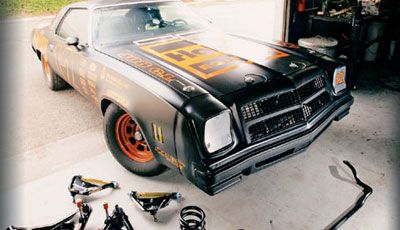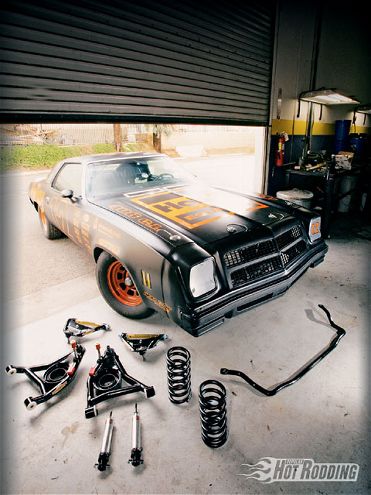

The numbers are simply staggering. Between 1973 and 1977, General Motors built 7.4 million intermediate coupes, sedans, wagons, and car-based trucks. These ranged from mundane garden-variety Chevy Malibu station wagons, all the way to premium coupes like the Pontiac Can Am, Laguna S-3, and Olds 442. Every one of them had the exact same Radial Tuned Suspension (RTS), which was ground breaking for its day. RTS was the first time a suspension had been designed substantially from the ground up by computers. RTS addressed many previously elusive bad handling traits that arose from positive camber gain, excessive scrub radius, and an absence of self-centering caster. GM's RTS marked the first time a major manufacturer demonstrated a comprehensive understanding of all the subtleties of modern suspensions in one vehicle architecture. Moreover, RTS was the first time a suspension had been designed specifically for radial tires.
The PHR '75 Laguna, like all '73-77 GM A-bodies, has the factory RTS. Like its contemporaries, the Laguna's stock suspension is lightyears ahead of the earlier '64-72 A-body design, so building a better mousetrap really doesn't involve a lot of trick alterations to the stock geometry that you typically see on earlier A-body aftermarket suspensions. What is a concern in these older cars--especially if performance driving is the end goal--is to beef up the control arms to withstand the punishment of big g forces. Another equally important concern is to rid all of the moving joints of binding and friction. Even new replacement rubber control arm bushings will create unpredictable handling near the limit, spoiling your fun as you turn in for that high-speed apex.
With so many mid-'70s A-bodies out there, you could be forgiven for thinking there are a lot of aftermarket front suspension pieces out there, but in fact, Global West was the only company making anything at the time we performed these mods to our Laguna project car. We were fortunate to discover Global West practically in our back yard--San Bernardino, California--and took our "tribute" stock car racer there in person. (You'll recall we installed our rear suspension at Global West last month.) So how exactly does Global West address the concerns mentioned above?
In the control arm department, the G-Plus upper arms are built with 1.25-inch diameter steel tubing, with a 0.187-inch-thick wall brace to reduce flex. Billet steel cross shafts also have a touch more camber curve built into them for more aggressive cornering. Global West's lower arms use even thicker 1 5/8-inch steel tubing, and feature a trick rotating spring mount with a stepped pigtail receiver made of polyurethane. This allows you to index your springs perfectly for a level ride. Both upper and lower arms can be ordered with Del-a-lum bushings, to create a near frictionless pivot, and therefore more predictable handling at the edge.
If it sounds to you like a whole lot of severe-duty hardware for a hard-core dual-purpose street/track car, you've got the idea. This stuff can take a pounding, and Global West has built in the beefcake in designing these pieces for maximum track abuse. The strength built into the G-Plus upper and lower control arms is confidence inspiring, and we plan on putting it to the test once project Laguna sees completion. But lower control arms aren't the only component that needs to be addressed.
The spring/shock package is equally critical for a track-bound car, and Global West's solution in this area doesn't disappoint. Global West offers two front spring packages for '73-77 GM A-bodies: a Street spring (part No. S-14, $162.99 pr) with a 1-inch drop and a slightly higher rate, and the Extreme Performance Handling spring (part No. S-15, $162.99 pr), also with a 1-inch drop, but with about 30 percent more spring rate. For the driving we plan, the Extreme Performance spring got the nod. For shocks, we chose the QA1 Stocker Star shock in a double-adjustable configuration. These bolt-in shocks are intended for hardcore on-track use, and feature a lightweight aluminum body, hard-chromed centerless-ground piston rods, double-lip wiper seals, and deflective disc valving. The double-adjustable QA1s have separate knobs for compression and rebound damping, and while most sources (including QA1) still quote 12 positions for each knob, we actually discovered our units had 32 discrete detents for compression, and 37 for rebound.
Rounding out our Laguna's front suspension are a Global West 1 1/8-inch-diameter sway bar, and a bumpsteer kit from Baer Brakes. Given our stiffer spring package, we elected not to go with the stiffer 1-inch diameter sway bar (part No. SB-709, $215.39), and installed the softer 1 1/8-inch bar instead (part No. SB-883, $199.95). As a rule of thumb, you generally want sway bar stiffness to run counter to spring stiffness because stiffer springs will naturally cause the car to corner flatter on their own.
Including the alignment on Global West's alignment rack, the front suspension took an entire 12-hour day. Why so long? We actually installed and removed the springs three times to check the ride height, and make adjustments to the spring height, which almost doubled the total install time. We felt that effort was worth it, and the ride height and the handling are much better off for it. We also replaced some of the stock steering pieces, like the drag link and inner tie-rod ends, which ate up some time.
As for the ride quality, the spring and shock package have firmed up the feel tremendously; the Laguna no longer heaves and pitches over bumps like a tuna boat on a rough sea. Handling is now tight and light, with the biggest difference being felt in the perceived mass of the car. We like the sharp turn-in and flat cornering, and look forward to testing it on the autocross and road course, but before tackling that, we'll need good brakes, and some power under the hood.
PROJECT TALLADEGA THE COST SO FAR DESCRIPTION: PHR ISSUE: COST: 1975 Chevy Laguna October 2008 $5,000 Phoenix 700R4 trans & converter* February 2009 $2,800 Sherwin Williams paint, materials, & labor March 2009 $3,979.73 Makeover (tires, wheels, graphics, seats, etc.) April 2009 $2,989.95 T&L 408ci solid-roller small-block* May 2009 $7,685 Global West rear suspension June 2009 $1,699.36 Global West front suspension July 2009 $2,569.83 TOTAL: $26,723.87*not installed in car yet
WHERE THE MONEY WENT DESCRIPTION: SOURCE: PART NO.: PRICE: Upper control arms (pair) Global West CTA-37A $673.76 Lower control arms (pair) Global West CTA-37L $788.15 Springs (pair) Global West S-15 $162.99 Double-adjustable shocks (pair) QA1 DTC-1914P $579.98 Front sway bar Global West SB-883 $199.95 Bumpsteer kit Baer Brakes 3301013 $165.00 TOTAL: $2,569.83